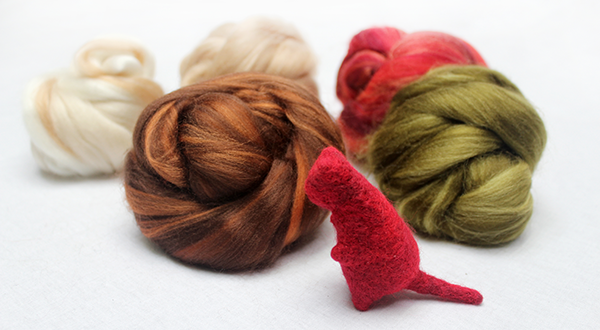
Darrin, our needle felting teacher at the Lion Brand Yarn Studio in New York City, shares some insights into this fun and sculptural craft technique. Shop felting tools on LionBrand.com.
If you knit or crochet, then you know how important it is to follow the pattern. Obtaining the correct gauge, and counting stitches and rows are all required to be certain that your project will turn out like the pattern describes. With needle felting you can forget about all of that!
I hope you will find needle felting liberating as I do, it is refreshing to be free from all of that regulated structure. Take back control of your yarn crafting, and make choices as you go. Often, if I don’t like something, I just take my scissors and cut it off of my work. It is very liberating to work in a creative free-form way, where you can decide as you go if you like how your work is turning out.
Needle felting is a popular fiber arts craft that creates felt without the use of water. Fiber artist Eleanor Stanwood first used special needles that were originally used in industrial felting machines in the 1980s to sculpt wool by hand. Now this art form is gaining in popularity.
Frequently, the needles are described as having barbs, spurs, or notches, along the shaft of the needle that grab the layers of fibers and tangle them together as the needle passes through the wool fiber. These notches face toward the tip of the needle and do not pull the fibers out as the needle exits the wool. Once tangled and matted, the felt can be very strong and used for creating fabric, jewelry, 3D sculptures, and just about any thing that you can imagine. This is a very versatile art form, and you can really achieve very fine detailed work.
Recently, I was having a party for some friends who wanted to learn how to needle felt. I was very excited to teach my friends about this art form since I really enjoy felting. My good friend Arabia was not able to come to the event because she is vegan, and she does not use wool. I wanted to find a way to include her, but still respect her vegan lifestyle. Even though I have always been told only wool and other animal fibers will felt, I had seen industrially-made acrylic felt for crafting projects.
I tried to research felting with acrylic yarn in the Internet, but I couldn’t find any information, so I just decided to try it myself. I used Vanna’s Choice yarn (which is 100% premium acrylic) with the Clover needle felting pen tool and the large Clover needle felting mat. I was pleased to discover that the 100% acrylic yarn needle felted beautifully. This was a wonderful discovery because now my vegan friend could join the party!
Flat needle felting can be done on fabric that is soft enough for the needles to pass through easily. This can include felted, knitted, crocheted, or store-bought fabric. You might have an old sweater or accessory item that has a hole or stain. Now instead of getting rid of it, you can needle felt a design to repair the damaged area. If you are not sure if it will work, just try it. If the fabric is too stiff the needles might break.
Three-dimensional sculptures are also fun to make with needle felting. If you are able to imagine it, you can create it.
Related links:
Karen
Could needle felting be used in place of the embroidery featured in the family heirloom felted afghan in your recent catalogue?
Zontee
Absolutely! It may be a little trickier to get the level of detail of embroidery with needle felting, but you can definitely needle felt designs into those blocks.
Rebecca Anne Vance
When you felted with acrylic yarn, did you come it out first? I’m looking for something to use to applique details on to a stuffed animal I’m crocheting.
Raven Saint
I use Pet brushes for my yarns. I think they are called slicker brushes. They have fine wire “bristles” that are bent a bit. You use two of those and brush against each other to pull the yarn apart. Find a video about carding wool, it’ll show how the carders look, and the pet brushes I mention look similar. Just be careful doing this as you don’t want to damage the fibers too much in the process. It’ll take time, but acrylic fibers come out like soft roving for dry felting. Enjoy your felting. (Note: Don’t use the Pet brushes (carders) for anything else besides the yarn.)